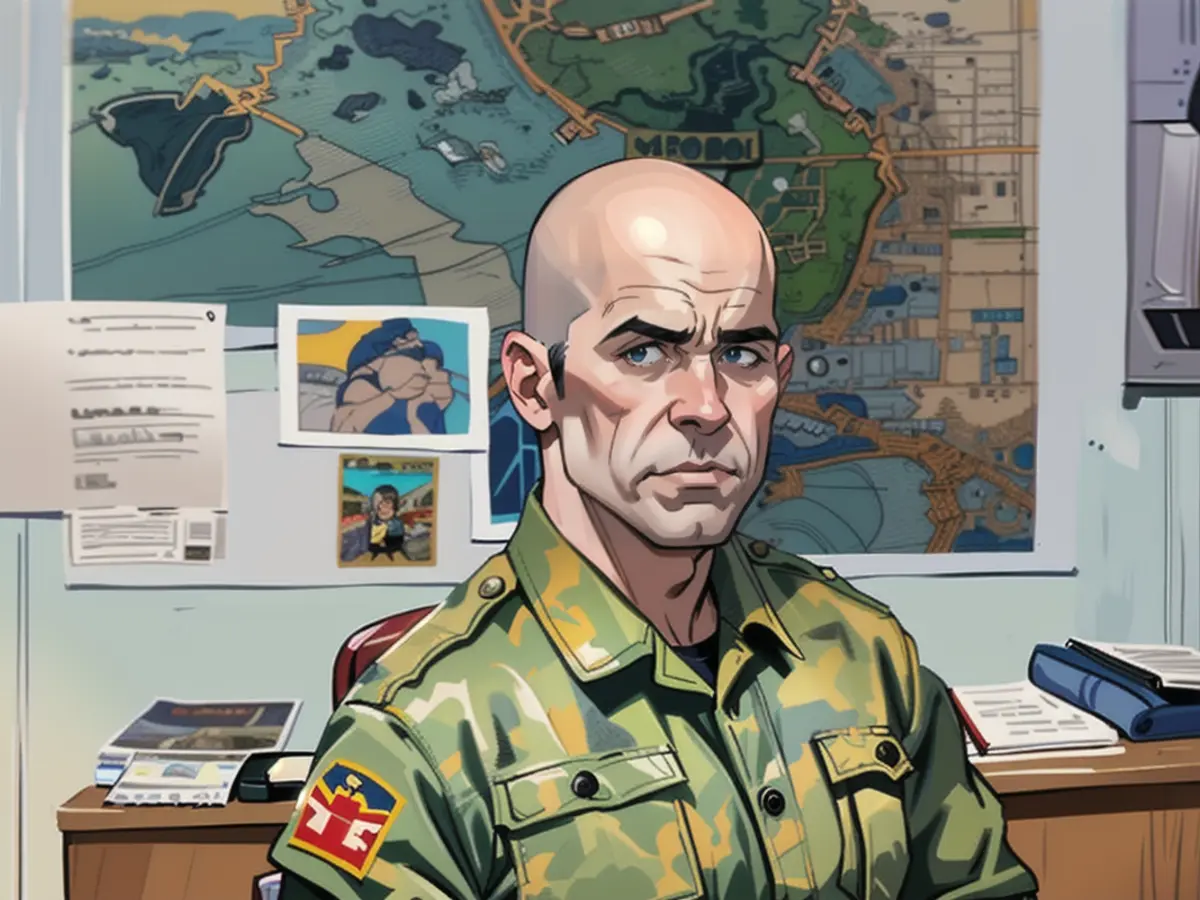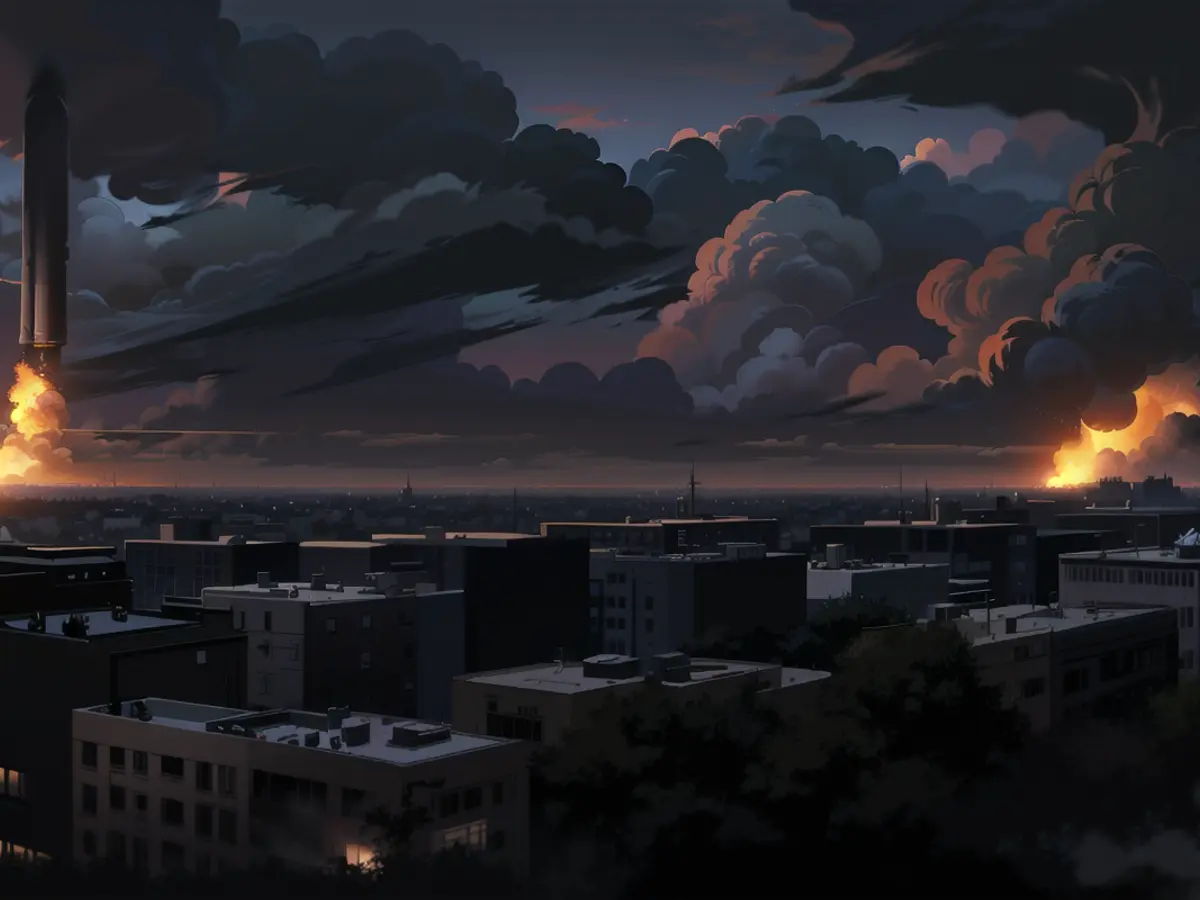Russians heavily assault the entire front line.
According to Col. Markus Reisner in an interview with ntv.de, since the US's approval, Ukraine has used multiple rocket launchers to target Russian territory. This is done to stop a potential offensive in the north. On other fronts, Russia is reportedly advancing successfully.
ntv.de asked about the recent developments on the front lines. Reisner said that the Russian offensive north of Kharkiv has been halted by Ukrainian forces. The Ukrainian army has moved troops from other areas and sent them, combined with reserves, to the north to slow down the Russian advance. There have also been local Ukrainian counter-attacks without gaining any ground.
Has the provision of western weapons against Russian territories had an impact yet? Reisner replied that Ukrainian officials expect an expansion of the Russian offensive, especially northwest of Kharkiv, near Gravhorod, between Sumy and Kharkiv. The Russians are amassing forces there, and the Ukrainians are deploying HIMARS systems to deter this potential offensive.
Is there any information on the effectiveness and ammunition used by the HIMARS? Reisner noted that social media has images of packaging containers for the GMLRS rockets fired by the HIMARS. These containers suggest that at least several dozen, if not more than a hundred, have been fired. However, there are no images of the impacts. During the summer of 2022, the internet was flooded with images of Russian ammunition depots destroyed by western weapons.
Has Russia improved its control over the information space compared to before? On both sides, the ability to handle the information space has increased. The number of mobile phone recordings of impacts on social media has significantly decreased. In Ukraine's case, we mainly find out about strikes on power plants when the energy suppliers announce power outages.
Were the western weapons against Russian territories prepared in advance? It is assumed that they were, as the appearance of GMLRS packaging images was most likely intentional, signaling to the information space, "We have started."
Which other approved weapons systems could Ukraine use against Russian territory? In principle, anything that the HIMARS fires can be used, including GMLRS and ATACMS rockets. Additionally, there is artillery, such as the German PzH 2000 howitzer. Also, air defense systems, like the Patriot systems provided mainly by Germany, could be stationed at the border to prevent Russian combat aircraft from firing guided bombs into Ukraine from a safe distance.
Russia launched intense attacks along the entire front, with success in two areas: Chassiv Yar, where the Ukrainians are defending the Siverskyi-Donetsk-Donbass Canal, and Ocheretyne, where the Russians advanced along the second line of Ukrainian defense.
The Russians are using a similar tactic to World War II: starting with air raids, including the use of glide bombs, followed by a advance of heavily armored vehicles like "Sturmgeschütze," and sometimes mine clearers at the front. This allows them to repeatedly break through. If the Patriot systems were moved to the Ukrainian-Russian border, they could prevent Russian combat aircraft from dropping glide bombs behind the border.
There have been heavy air raids on Ukraine over the weekend. Ukraine claims to have shot down 35 of the 53 rockets and missiles in the latest attack, a hit rate of 66%. In May, there were three major attacks, and now another one at the beginning of June. The damage to water and heating power plants is leading to periodic power outages.
What is the military value of Russia's campaign? This is part of the strategic level of Russian warfare, designed to reduce Ukraine's ability to sustain the war for a long time. The attacks on critical infrastructure aim to limit Ukraine's military-industrial production capabilities and put pressure on the population and erode their support for their government.
In the past few months, Ukraine has seen ongoing discussions about a new wave of mobilization. Recent reports indicate that recruits are even being trained directly at the front. What are your thoughts on these developments?
How do you think commanders cope with the task of rapidly training soldiers for combat situations? They face the additional challenge of allocating staff for this, as the Ukrainian government pushes for more troops. Images from Ukraine show young men being approached on the street and, in some instances, forcibly dragged to training facilities.
Does mobilizing unenthusiastic recruits benefit the army in any way? Could their combat morale be significantly lower than that of the initial volunteers who joined during the first weeks of the war?
While it's true that the currently deployed forces are becoming overloaded, it's important to realize that the Ukrainian government needs to supplement their ranks. With over 33 million people eligible for military service, they desperately search for fresh manpower. On the other hand, Russia has 150 million people, and they constantly recruit new soldiers from their conscription system. Russia currently has 520,000 soldiers actively engaged, more than double the number at the start of their invasion. Ukraine, with a total of 880,000 soldiers on duty, has 400,000 of them in active combat roles.
What's the impact of the ongoing war on troop morale after a year of relentless defense?
It's undeniable that the uncertainty surrounding Western military support has an effect on troop morale. However, the soldiers often reiterate that there's simply no other choice. Their country is under attack and needs protection. Over the past 831 days, since the invasion began, and extending back eight years to the annexation of Crimea and the fighting in Donbass, the Ukrainian people have grown weary of war. Yet, they're still compelled to uphold the front lines. If the Russians launch a new offensive in Sumy, they'll be asked to do even more.
Can attacks on Russian territory with Western weapons create a renewed sense of momentum to motivate Ukrainian troops?
This theory would only hold true if these attacks resulted in tangible achievements. At this point, the number of available systems for offensive operations is restricted. Consider the situation with artillery and ammunition, for instance - there's only so much of it. Meanwhile, Russia can gather resources from North Korea and China. This war of attrition will essentially be determined by the availability of resources.
What sets French military trainers apart from training Ukrainians on European soil?
By sending trainers to Ukraine, the commanders at the front would be relieved of their training responsibilities. Historically, fewer logistic steps would be involved, too, since not hundreds of Ukrainian soldiers would need to travel back and forth. The EU has stricter regulations, while Ukraine has more relaxed training standards, particularly in terms of the use of drones. Additionally, sending trainers would signify a show of support.
Do Western nations still offer valuable training to the Ukrainian army?
Ukrainian soldiers often find European training courses disappointing due to curriculum discrepancies with their combat experience. For instance, drones are heavily utilized in Ukraine, but many are destroyed within a single operation. European armies, on the other hand, don't use drones in similar ways, making it difficult for Ukrainian soldiers to find comparisons. Western forces have also garnered considerable experience in Iraq and Afghanistan, both markedly different scenarios than the Ukrainian conflict. There, they encountered opponents with less advanced weaponry, whereas in Ukraine, both sides face each other with relatively similar capabilities. For NATO troops, it's difficult to comprehend what the front in Ukraine looks like. Besides talking to my Ukrainian counterparts, I often think of the movie adaptation of "All Quiet on the Western Front". The battle scenes from the 1930 film are reminiscent of the First or Second World War, with a relatively open battlefield and trenches. Drones constantly monitor the frontlines from aerial heights and first-person view drones target the soldiers. It's a terrifying experience. In Afghanistan, we were wary of landmines and ambushes, but we didn't endure artillery fire on par with the First World War.

Read also:
- The Ukrainian army has been using US-approved multiple rocket launchers, such as the Himars, to respond to Russian attacks and halt their offensive in the north.
- To deter a potential Russian offensive in the northwest of Kharkiv, Ukraine is deploying Patriot air defense systems provided mainly by Germany at their border.
- Russia has been heavily using drones in their attacks on Ukraine, and there have been reports of western weapons being used to target these drones, potentially from the Patriot systems deployed by Ukraine.








